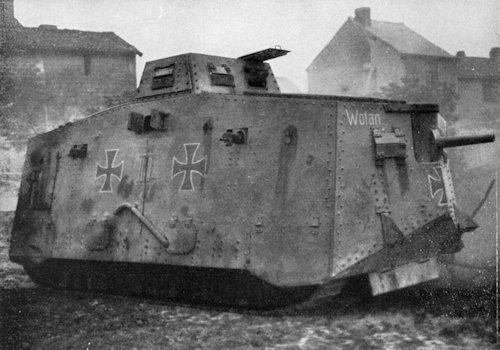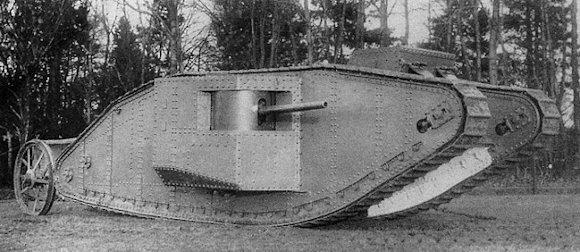101 years ago, and exactly the 16 January 1916, the first tank prototype debuted, the British Mother (photo opening); formerly some vehicles that were used to armor had moved on the battlefields, but they were not real tanks.
The farsighted British government ordered studies by Walter Wilson and Philip Johnson who developed a medium that convinced the war hierarchs; so a hundred pieces were produced to which the name Mark was attributed but it was a half disappointment.
Half of them were destroyed after a few meters, as the German artillery was perfectly able to pierce the thin armor of the Mark (10mm).
But the terror generated by the appearance on the battlefield of the new instrument of war aroused the desire to emulate the British armed forces; The German A17Vs (photo on the right) appear on the scene on December 1917, 7, which gave the Teutonic the illusion of being able to easily win the war.

Nothing more illusory, in the 1918, 99 years ago, the American tanks broke onto the battlefield and gave a blow to the dreams of Germany; meanwhile the British after the Mark V, evolution of the first battle vehicle built the Wippet Medium first tank driven by one man.
France did not want to be outdone and Renault workshops went to work churning out the light and cheap FT; in this scenario Italy was totally dependent on France and England but soon the Fiat Ansaldo began producing the FIAT 3000, just on the eve of the armistice signed the 4 November 1918.
A few months earlier the British pioneer of the warring strategy John FC Fuller elaborated the kangaroo tactic, exploiting armored vehicles to break through enemy lines and lay soldiers behind opponents with devastatingly psychological effects.
The Germans were displaced, the strength of their ATVs was defeated by the intelligence of the enemy tactics that the 8 August 1918 at Amiens broke through enemy lines on a front more than 40 km.
The war ends but not the production of tanks; the American J. Walter Christie conceived fast vehicles, with suspensions to move easily on uneven ground, revolving turret and sloping shell to deflect the anti-tank shots: the glorious T3 is born, we are in the 1931.
The industrial war intelligence quickly leads the Russians to "copy" the American technologies revived on the T34 up to the T62, but the real news was the use of the radio as a control system.
 In the beautiful country Benito Mussolini encouraged the development of tanks even if they were conceived simply as support for the infantry or as reconnaissance vehicles given the limited conception that the Duce had armored vehicles; so L3 (left) were born, simple tracked with two crewmen and armed with machine guns and flamethrowers.
In the beautiful country Benito Mussolini encouraged the development of tanks even if they were conceived simply as support for the infantry or as reconnaissance vehicles given the limited conception that the Duce had armored vehicles; so L3 (left) were born, simple tracked with two crewmen and armed with machine guns and flamethrowers.
World War II gave rise to numerous technical and strategic projects; the invasion of Poland showed the power of that weapon in the world if used in a certain way, the Panzer were Nazi terror, the lightweight PzKw I and the middle PzKw III and IV easily fought the Polish front in a few days.
The same happened to the best French tanks whose anti-tank vehicles proved ineffective; the Italian media in North Africa proved to be the soft ax of the Axis, the tenth army had supplied the above L3 and the modest M11 which were easily wiped out from the best equipped Matilda supplied to the British.
The arrival on the war front of the most powerful M13 with a 47 mm cannon and a 40 mm armor did not change the fate of the Italian troops that were supported by the arrival of the Germans to rebalance the fate of the conflict in the black continent.
 The Italian soldiers, however, wrote epic pages in those situations, not for the power of the means available but for the wit and courage of their troops; on the other front the vehicles of the Fuhrer were outclassed by the Soviet ones in the Russian campaign, the T34 (photo on the right) and the Soviet T76 proved to be superior to all the Teutonic tracked vehicles
The Italian soldiers, however, wrote epic pages in those situations, not for the power of the means available but for the wit and courage of their troops; on the other front the vehicles of the Fuhrer were outclassed by the Soviet ones in the Russian campaign, the T34 (photo on the right) and the Soviet T76 proved to be superior to all the Teutonic tracked vehicles
Hitler could not accept this whammy and in a few months the Tiger I and the Panther D were designed and produced, equipped, among other things, with tungsten carbide bullets able to pierce the armor of the Soviet tanks.
German superiority also manifested itself to the English Churchill and the American Sherman, but in the medium run these fast-built and ferocious vehicles in the German workshops using maneuvering from the field of work proved unreliable for the mechanical problems due to the sabotage they were victims of construction site.
The Fiat Ansaldo produced at that time the P40, a 25 t carriage and a 75 mm cannon, but it was too late, the war was already lost.

After World War II a program was drawn up on a world scale to reduce the tanks but the agreement was not reached between the two super powers, therefore between the 1950 and the 1960 were born the Soviet T54, the T55 and the T62; the Americans responded with the M46-47-48 (pictured left) better known as Patton. The occasion for the clash between Soviet and Western tanks was the Six Day War (1967), won by the Israelis who benefited from American and French vehicles, the success was repeated in the 1973 in the Kippur war.
The great German battlefields, the American Abrams, the English Challenger and the Israeli Merkava in the 80 years were built on the scene, with the help of modern technology.
The Gulf War is around the corner, the Iraqi troops were swept away in a few days (pictured below) and especially at night, thanks to the thermal visors of the Americans opposed to the infrared viewers of Saddam's men.
The tanks continue the long history, 101 years of glory.
 (photo: web)
(photo: web)












